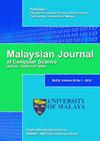PREDICTION OF CYCLONE USING KALMAN SPATIO TEMPORAL AND TWO DIMENSIONAL DEEP LEARNING MODEL
IF 1.2
4区 计算机科学
Q4 COMPUTER SCIENCE, ARTIFICIAL INTELLIGENCE
引用次数: 0
Abstract
Cyclone Classification and Prediction models rely on large intensity based on the maximum speed of the wind, along with the classification of intensity. The computational constraints blended with the formation of those intensities, cyclone classification and prediction firmly depreciate the full range of optimal features required for classification and hence accurate representation is less possible. Keeping this point, our study inspects the potential of Spatio-temporal features using a machine learning algorithm as an alternative to the current study of cyclones. This method is called, Spatio-Temporal Kalman Momentum and Two Dimensional Deep Learning (SKM-2DDP) for cyclone classification and prediction. To start with, pre-processing is performed by applying the Kalman Momentum Conservation Filter mechanism based on the design of the Dvorak technique to obtain optimal estimates of state variables and reduce the computational burden involved to remove noise from input cyclone images. With the resultant denoised input cyclone images, Spatio Temporal Feature Extraction is performed. Features obtained from the inherent intrinsic properties of pre-processed cyclone images of several weather conditions result in successful classification. Followed by pre-processing, in this work, features constituting both pixel-wise intensities over time and the directional length are being considered. The dependency of autocorrelation with each pixel’s intensities over time and two temporal features are helped for coarse classification of weather conditions according to their visual effects. Finally, with the inherent intrinsic features extracted, a Two Dimensional Deep Learning model is utilized to foretell the cyclone intensity. Experimental evaluation of the proposed SKM-2DDP method is accomplished using images of cyclone dataset with many factors just as peak signal to noise ratio, prediction accuracy, prediction time and false-positive rate. Our own selves have considered with several cyclone images acquired from two different cyclone image datasets namely OCKHI_DEC2017 and VARDAH_DEC2016.基于卡尔曼时空和二维深度学习模型的气旋预报
气旋分类和预测模型依赖于基于最大风速的大强度,以及强度分类。计算约束与这些强度的形成、气旋分类和预测相结合,大大削弱了分类所需的所有最佳特征,因此准确表示是不可能的。保持这一点,我们的研究使用机器学习算法来检查时空特征的潜力,作为当前气旋研究的替代方案。这种方法被称为时空卡尔曼动量和二维深度学习(SKM-2DDP),用于气旋分类和预测。首先,通过应用基于德沃夏克技术设计的卡尔曼动量守恒滤波器机制进行预处理,以获得状态变量的最佳估计,并减少从输入气旋图像中去除噪声所涉及的计算负担。利用所得到的去噪输入气旋图像,进行时空特征提取。从几种天气条件的预处理气旋图像的固有特性中获得的特征导致了成功的分类。然后是预处理,在这项工作中,考虑了构成随时间变化的像素强度和方向长度的特征。自相关与每个像素的强度随时间的依赖性和两个时间特征有助于根据天气条件的视觉效果对其进行粗略分类。最后,通过提取固有的内在特征,利用二维深度学习模型预测气旋强度。利用气旋数据集的图像,结合峰值信噪比、预测精度、预测时间和假阳性率等因素,对所提出的SKM-2DDP方法进行了实验评估。我们自己已经考虑了从两个不同的气旋图像数据集(即OCKHI_DEC2017和VARDAH_DEC2016)中获得的几个气旋图像。
本文章由计算机程序翻译,如有差异,请以英文原文为准。
求助全文
约1分钟内获得全文
求助全文
来源期刊

Malaysian Journal of Computer Science
COMPUTER SCIENCE, ARTIFICIAL INTELLIGENCE-COMPUTER SCIENCE, THEORY & METHODS
CiteScore
2.20
自引率
33.30%
发文量
35
审稿时长
7.5 months
期刊介绍:
The Malaysian Journal of Computer Science (ISSN 0127-9084) is published four times a year in January, April, July and October by the Faculty of Computer Science and Information Technology, University of Malaya, since 1985. Over the years, the journal has gained popularity and the number of paper submissions has increased steadily. The rigorous reviews from the referees have helped in ensuring that the high standard of the journal is maintained. The objectives are to promote exchange of information and knowledge in research work, new inventions/developments of Computer Science and on the use of Information Technology towards the structuring of an information-rich society and to assist the academic staff from local and foreign universities, business and industrial sectors, government departments and academic institutions on publishing research results and studies in Computer Science and Information Technology through a scholarly publication. The journal is being indexed and abstracted by Clarivate Analytics'' Web of Science and Elsevier''s Scopus
 求助内容:
求助内容: 应助结果提醒方式:
应助结果提醒方式:


